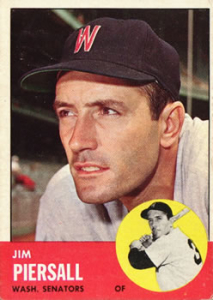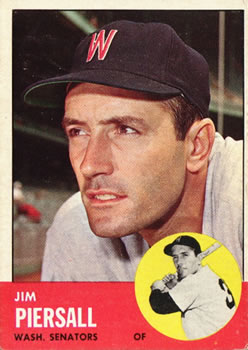June 23, 1963: Jim Piersall celebrates 100th career home run with backward trot around the bases
 In July 1952 Boston Red Sox rookie and Opening Day shortstop Jim Piersall was hospitalized with manic depression, more recently classified as bipolar disorder. Struggling to learn the nuances of switching positions from the outfield, coupled with the fear of failure, Piersall with his seeming playfulness on the field became progressively troublesome. He fought with opposing players and teammates alike and increasingly berated umpires.
In July 1952 Boston Red Sox rookie and Opening Day shortstop Jim Piersall was hospitalized with manic depression, more recently classified as bipolar disorder. Struggling to learn the nuances of switching positions from the outfield, coupled with the fear of failure, Piersall with his seeming playfulness on the field became progressively troublesome. He fought with opposing players and teammates alike and increasingly berated umpires.
Piersall’s erratic behavior forced the club to take action, and in late June he was optioned to Birmingham of the Southern Association. When his anger and bizarre antics did not abate, Red Sox general manager Joe Cronin decided that Piersall should see a psychiatrist.
With a prescription for lithium to stabilize his mood swings, Piersall returned to the Red Sox outfield in spring training 1953. During the next six seasons in Boston his career blossomed. He became a fixture in the Red Sox lineup and was selected for two All-Star Games. His anger and mood swings were suppressed, but his on-field gregariousness continued. He enjoyed funny and playful interaction with fans and delighted in bench jockeying with players and umpires.
Piersall’s performance declined in 1958, and in the offseason Boston traded him to Cleveland for Vic Wertz and Gary Geiger. He spent three years with the Indians, then one in Washington with the Senators. In May of 1963 he was traded to the New York Mets for Gil Hodges1 and joined the second-year expansion club managed by the colorful Casey Stengel.
The 34-year-old Piersall was immediately slotted at the top of the Mets lineup as the everyday center fielder. He was tasked to provide a jolt to the New York offense as well as dispense some levity to the fans and clubhouse.
When the Philadelphia Phillies faced the Mets in a Sunday doubleheader at the Polo Grounds on June 23, Piersall was manning center field and batting leadoff in game one. Right-hander Carl Willey, purchased from the Milwaukee Braves in March, was pitching for New York, aiming for his sixth win of the year, to tie him with Al Jackson for the team lead.
On the fourth stop of a five-city, 17-game road trip, the Phillies were eighth in the National League, ahead of only the ninth-place Houston Colt .45s and the 10th-place Mets. Manager Gene Mauch presented a revised lineup to counter Willey. In a loss to the Mets in the first game of the series, the Phillies manufactured only one run off Jackson, and third baseman Don Demeter committed two errors. Sunday’s roster presented Rubén Amaro at third base, with Demeter moving to left field and bumping slugger Wes Covington’s bat to the bench. “I may regret it when I’m involved in a one-run or two-run game, and big Covington’s big bat is sitting there in the bat rack. Where we’ll get the runs, I don’t know for sure,” said Mauch.2
The Phillies went quietly in the first three innings. Willey struck out four of the first 10 batters and did not allow a baserunner until Johnny Callison stroked a triple with one out in the fourth. Tony González followed with a grounder to rookie shortstop Al Moran. Callison broke for home, and Moran’s throw to catcher Choo-Choo Coleman nailed Callison at the plate.
Righty Dallas Green got the start for the Phillies. Green debuted with Philadelphia in 1960, and during his tenure with the team had been in and out of the starting rotation. By 1963 he was primarily a reliever with occasional starting assignments. (Green went on to briefly pitch for the Mets in 1966; he also subsequently managed both the Phillies and Mets, leading the Phillies to the 1980 World Series championship.)
Piersall greeted Green in the bottom of the first with a single to right field. With Ron Hunt batting, Piersall took off for second and was gunned down by Phillies catcher Clay Dalrymple. Hunt and Duke Snider singled, but 18-year-old Ed Kranepool’s grounder ended the threat.
Coleman singled leading off the second but was stranded. In the third, the Mets scored their first run. Tim Harkness and Hunt walked, and Snider singled to right to drive in Harkness. On a swinging strike three to Kranepool, Snider broke for second. Dalrymple threw to shortstop Bobby Wine, but when Hunt broke for home, Wine returned a perfect throw to the plate, nailing him.
In the fourth, the Mets had traffic on the bases again, but the Phillies defense bailed out Green by turning another double play. Coleman singled, Moran walked, and Willey hit a grounder up the middle. Second baseman Tony Taylor shuffled the ball to Wine, forcing Moran, and Wine tossed to first to erase Willey.
Willey retired the Phillies in the top of fifth, and the score remained 1-0 as Piersall led off the bottom half. In his monthlong tenure with the Mets, Piersall had yet to hit a homer. He had hit 99 home runs with his three previous teams, and had been planning for weeks what he would do when he hit his 100th.
When he informed his teammates that he was going to run the bases backward, they thought he would run them clockwise. He replied, “What do you think, I’m a nut? That’s against the rules, but there’s no rule against what I’m going to do.”3
Piersall lofted Green’s first pitch toward the 258-foot sign down the right-field line. The ball carried just long enough to plop into the second row of seats for a home run.4 As Piersall rounded first, he pivoted and started running backward. The crowd gave him a standing ovation as he looked over his shoulder while crossing second, third, and home.
Stengel was not surprised that Piersall executed the maneuver. “He touched every base, didn’t he?” Stengel said. “He just wanted to let everyone know he hit a homer. That’s a backward dance step he got in a dance hall.”5
Trailing 2-0, Green completed the inning, then gave way to the bullpen. Relievers Chris Short and John Boozer escaped the sixth unscathed, but the bullpen fell apart with one out in the seventh. Boozer walked Harkness, who stole second, and Snider was intentionally walked. Mauch pulled Boozer and summoned lefty Dennis Bennett to pitch to the left-handed Kranepool. Stengel countered Mauch’s move by inserting righty pinch-hitter Jim Hickman.
Bennett’s first pitch bounced past Dalrymple and the runners advanced. With the count full, Hickman hit a grounder down the third-base line. Amaro snagged the hot shot, but his throw pulled first baseman Roy Sievers off the bag. Harkness scored on the error. Jack Baldschun replaced Bennett and surrendered a bloop single to Frank Thomas. Rod Kanehl, running for Snider, scored. Hickman advanced to third, then scored on Baldschun’s wild pitch. Three unearned runs had crossed the plate on one hit, one error, two walks, and two wild pitches.
The five New York runs were more than enough for Willey. The only other hit he allowed was a sixth-inning triple by Taylor that skipped by Kranepool in right. The 5-0 shutout was Willey’s third of the season.
The Mets won game two, and the doubleheader sweep lifted them out of the basement for the first time since May 16. The jubilant Stengel told his team, “You’re in ninth place now, and if you go nine places higher, you may be in first.”6 The euphoria was short-lived. New York ended the season with 111 losses and finished in the basement for the second straight year.
When the Phillies left New York, they were nine games below .500, their lowest mark of the season. Mauch continued to mix and match his lineup, successfully rotating 10 players in the eight positions. Philadelphia swept three games from the Pittsburgh Pirates, highlighted by Callison hitting for the cycle on June 27,7 and the Phillies gradually ascended in the standings. By season’s end, they occupied fourth place, 12 games behind National League champion Los Angeles.
Piersall played in 13 more games for the Mets and, having batted only .194 for the team, was released on July 27. He signed with the Angels and played there until he was released on May 12, 1967. The landmark home run off Green was the only round-tripper he hit for the Mets. Piersall notched four homers with the Angels, circled the bases forward each time, and concluded his career with a total of 104 home runs.
Acknowledgments
This article was fact-checked by Bruce Slutsky and copy-edited by Len Levin.
Photo credit: Jim Piersall, Trading Card Database.
Sources
In addition to the sources cited in the Notes, the author consulted Baseball Reference and Retrosheet for information, including the box score and play-by-play. In addition, the author consulted Jim Piersall’s SABR biography by Mark Armour.
https://www.baseball-reference.com/boxes/NYN/NYN196306231.shtml
https://www.retrosheet.org/boxesetc/1963/B06231NYN1963.htm
Notes
1 Hodges became Washington’s manager after the trade.
2 Stan Hochman, “A Backward Day for Sinking Phils,” Philadelphia Daily News, June 24, 1963: 44.
3 Dick Young, “Mets in Sweep, 5-0, 4-1; Piersall Bojangles’ HR,” New York Daily News, June 24, 1963: 20.
4 “1963 06 23 Phillies at Mets Game 1 – Polo Grounds Classic Baseball Radio,” YouTube video (Classic Baseball on the Radio), 2:32:16, https://www.youtube.com/watch?v=0Y_bTMKt1eo. Accessed August 2024. Piersall’s home-run call by Bob Murphy is at 1:09 in the broadcast.
5 Hochman, “A Backward Day for Sinking Phils.”
6 John Ryan, “Casey Sees Mets Moving Up After Sweep of Philadelphia,” Hackensack (New Jersey) Record, June 24, 1963: 20.
7 Mike Huber, “June 27, 1963: Phillies’ Johnny Callison Hits for the Cycle, Sparking ‘Merry-Go-Round of Base Runners,’” SABR Games Project, https://sabr.org/gamesproj/game/june-27-1963-phillies-johnny-callison-hits-for-the-cycle-sparking-merry-go-round-of-base-runners/.
Additional Stats
New York Mets 5
Philadelphia Phillies 0
Game 1, DH
Polo Grounds
New York, NY
Box Score + PBP:
Corrections? Additions?
If you can help us improve this game story, contact us.


